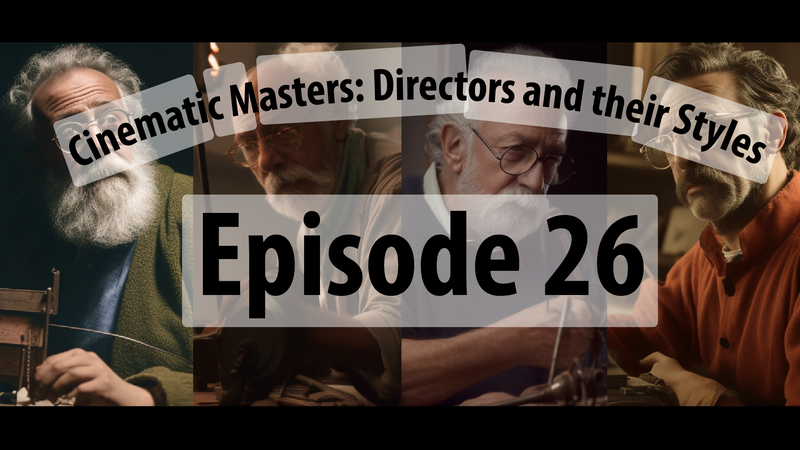Unravelling Cinematic Masters: An Intellectual Journey into Directors and Their Styles
In the vast tapestry of cinematic history, certain directors stand as beacons of creative brilliance, celebrated for their distinct styles and unparalleled contributions to the art form. As we embark on this intellectual exploration, we shall unravel the conventional wisdom surrounding these so-called "Cinematic Masters." Let us dissect their styles, challenge prevailing notions, and embark on a quest for a deeper understanding of their impact on the art of filmmaking.
The Quandary of Directorial Styles:
One must question whether directors truly possess a singular style that defines their oeuvre. It is tempting to weave a narrative around a director's work, attributing unique characteristics and motifs to them. However, a more discerning eye reveals that even the most revered directors are subject to evolution, adaptation, and occasional missteps.
Consider the case of Alfred Hitchcock, often hailed as the master of suspense. While his influence on the genre is undeniable, it would be remiss to paint his entire career with a single brushstroke. From the gripping psychological thrillers of "Psycho" and "Vertigo" to the lighter fare of "North by Northwest," Hitchcock's range demonstrates a complexity that defies facile categorization.
Similarly, Stanley Kubrick is renowned for his meticulous attention to detail and the symmetrical beauty of his compositions. However, reducing his directorial prowess to a mere stylistic gimmick belies the philosophical depths he plumbs in films like "2001: A Space Odyssey" and "A Clockwork Orange." Kubrick's style is but one facet of his artistic arsenal, serving as a vehicle for exploring profound themes rather than an end in itself.
Auteur Theory and Its Limitations:
Auteur theory, championed by the likes of François Truffaut and Andrew Sarris, posits that the director is the primary creative force behind a film, imprinting their vision onto the work. While this theory holds merit in some instances, it overlooks the collaborative nature of filmmaking.

The work of Quentin Tarantino, often cited as an auteur par excellence, provides a fertile ground for scrutiny. Tarantino's films are undeniably stamped with his unique brand of dialogue, violence, and pop culture references. Yet, a closer examination reveals his collaborators' undeniable influence, from his actors' inspired performances to the musical choices that shape the atmosphere of his movies. To ascribe sole authorship to Tarantino neglects the collaborative symphony that brings his visions to life.
Historical Perspectives and Paradigm Shifts:
To fully grasp the impact of these cinematic masters, we must view them through the prism of historical context. The evolution of filmmaking techniques, societal changes, and shifting cultural paradigms all leave indelible imprints on the works of directors.
Consider the revolutionary impact of Steven Spielberg. In the 1970s and '80s, his films like "Jaws" and "E.T. the Extra-Terrestrial" captured the imagination of a generation. Spielberg's style, characterized by sentimentality and accessible narratives, reflected the zeitgeist of a period marked by nostalgia and escapism. However, as the cultural landscape shifted, Spielberg adapted his directorial approach, delving into more complex themes in films like "Schindler's List" and "Saving Private Ryan." His later works challenged the notion of Spielberg as a purveyor of crowd-pleasing blockbusters, revealing a director unafraid to confront darker and more introspective subjects.
The Fallacy of the Magnum Opus:
Too often, we place undue emphasis on a director's supposed magnum opus, treating it as the definitive representation of their style and legacy. However, this reductionist approach overlooks the nuances and evolution present within their body of work.
Take Guillermo del Toro, a master of dark fantasy and visual storytelling. While "Pan's Labyrinth" is widely hailed as his crowning achievement, dismissing the breadth and depth of his other works would be a disservice. Films like "Hellboy" and "The Shape of Water" may differ in tone and genre, but they exhibit a consistent thread of Del Toro's unique blend of magical realism and profound humanity. By fixating on a singular magnum opus, we risk overshadowing the richness and diversity of a director's creative output.
Conclusion: Challenging the Conventional Narrative
In our pursuit of intellectual rigour and critical engagement, it becomes evident that the notion of Cinematic Masters and their defining styles is more complex than popular discourse suggests. Directors are not static entities bound to a singular vision but dynamic artists who evolve, adapt, and challenge our expectations.
By challenging the conventional wisdom surrounding these directors, we can appreciate their artistic evolution and the multifaceted nature of their styles. Moreover, rather than reducing their impact to a single magnum opus, we can explore the entirety of their filmography, examining how their work responds to the ever-changing cinematic landscape.
Let us approach the study of directors and their styles with an open mind, weaving a narrative that acknowledges their complexities, embraces collaboration, and remains attuned to the shifting paradigms of art and society. Only then can we truly appreciate the cinematic masters for their intellectual contributions to the world of filmmaking.


